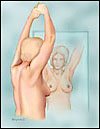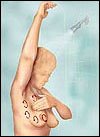31 Days of Breast Cancer Awareness: Self Exams
 Monthly self breast examinations (SBE;s) are recommended to aid early detection, which can lead to greater chances of survival.
Monthly self breast examinations (SBE;s) are recommended to aid early detection, which can lead to greater chances of survival.
Here are some general guidelines for conducting SBE’s.
SBE’s should take place several days after your period ends. If you are no longer having periods, choose a day that’s easy to remember every month.
The American Cancer Society recommends that doctors inform women about the benefits and limitations of breast self-exams when they reach the age of 20.
After age 40, a clinical breast exam and a mammogram is recommended to be performed every year in addition to self exams.
Here are five of the basic steps that you can use during your monthly self breast exam.
Note: There are many schools of thought on how this exam can vary but this is the most basic type of exam that you can proactively perform on yourself.
Step One – Begin Visual Review
This consists of standing in front of a large mirror, bent slightly forward at the hips with your shoulders straight and your hands pressing into your hips to engage the muscles.
You should face forward and turn from side to side to view all angles.
You are checking to make sure that your breasts look their normal shape, size and color.
There should not be any swelling, dimpling, redness, puckering or nipple inversion (turning in instead of out).

Step Two – Raise Arms Over Head
During this step, you are continuing your visual review looking for the same signs as you were when your hands were pressing at your hips.
You can also press your palms together (this engages the muscles in a different manner) and look for any changes.
Step Three – Check for Nipple Discharge
During this step you want to squeeze each nipple between your finger and thumb to make sure that there isn’t any fluid (bloody, milky or yellow) discharged.
Steps Four/Five – Physical Exam: Lying Down and Standing (in/out of the Shower)
The major differences between these methods is that when lying down you would use a folded towel to bolster your shoulder and when in the shower, you would lather your fingers and breasts with soap to help your fingers glide more smoothly over your wet skin.
This step is simply about preference. I prefer to lie down. I just feel that I am getting a better “feel”.
Lying Down –
Use a folded towel under your shoulder and extend your arm on an angle.
Use your right hand to check your left breast and then your left hand to check your right breast. You should check the entire breast area (12 o’clock to 12 o’clock) from your collarbone to the top of your abdomen, and from your armpit to your cleavage.
Follow a pattern to be sure that you cover the whole breast. Use the pads of your fingers and applying increased pressure with each movement, complete three dime size circles in each area of your breast.
Keep your hands on your breast at all times as you incrementally slide from one area to the next to insure that you cover the entire breast.

Standing In or Out of the Shower –
You should perform the same examinations that you did when lying down during this step.
Many women find that the easiest way to conduct the standing exam is when their skin is wet and slippery in the shower.
As noted above, lather your fingers and breasts with soap to make the movements easier.
Please remember that applying pressure to a breast lump may cause some discomfort. If you do detect any changes or lumps, seek medical attention immediately.
Sources: Mayo Clinic BreastCancer.org Susan G. Komen Foundation


